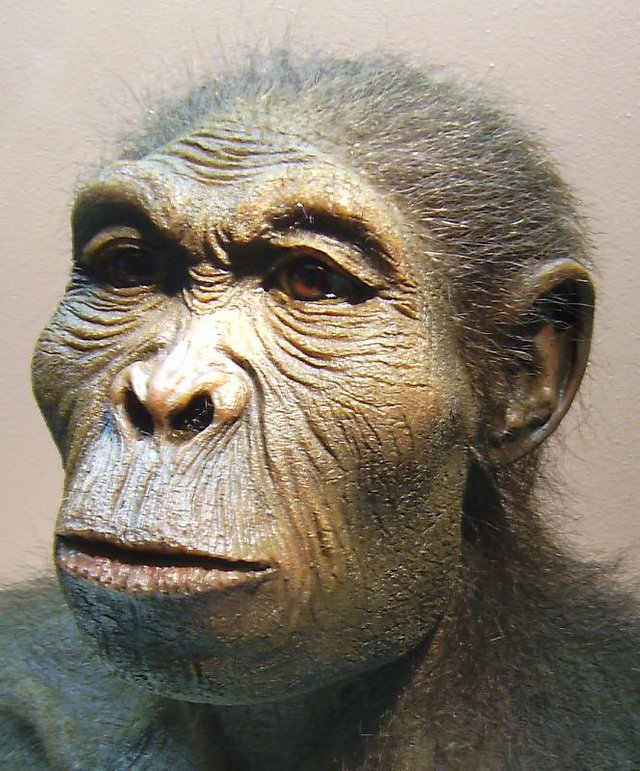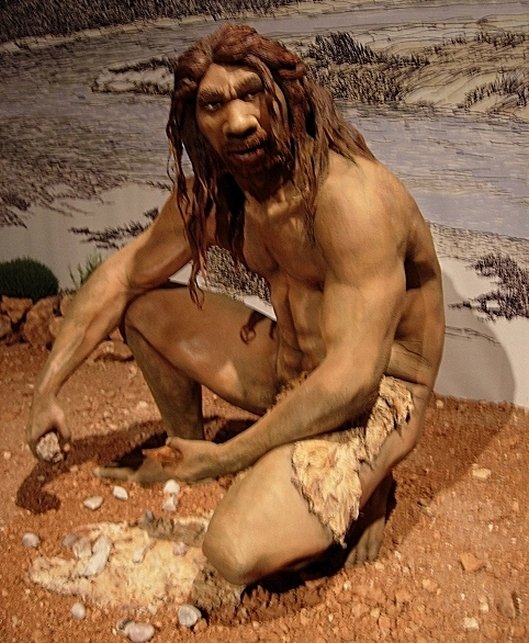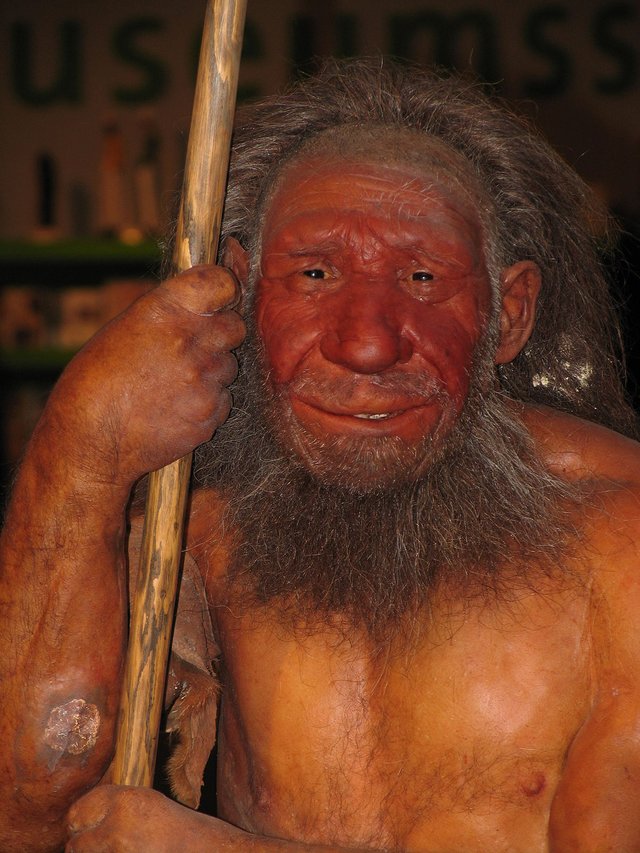
By unknown (klimaundmensch.de)
Homo_habilis.JPG: Photographed by User:Lillyundfreya
derivative work: Rafaelamonteiro80 (talk) - Homo_habilis.JPG, CC BY-SA 3.0, https://commons.wikimedia.org/w/index.php?curid=9503636
APE
Genus Homo[edit]
One current view of the temporal and geographical distribution of genus Homo populations.[113] Other interpretations differ mainly in the taxonomy and geographical distribution of hominin species.
A reconstruction of Homo habilis
Homo sapiens is the only extant species of its genus, Homo. While some (extinct) Homo species might have been ancestors of Homo sapiens, many, perhaps most, were likely "cousins", having speciated away from the ancestral hominin line.[114][115] There is yet no consensus as to which of these groups should be considered a separate species and which should be a subspecies; this may be due to the dearth of fossils or to the slight differences used to classify species in the Homo genus.[115] The Sahara pump theory (describing an occasionally passable "wet" Sahara desert) provides one possible explanation of the early variation in the genus Homo.
Based on archaeological and paleontological evidence, it has been possible to infer, to some extent, the ancient dietary practices[78] of various Homo species and to study the role of diet in physical and behavioral evolution within Homo.[75][116][117][118][119]
Some anthropologists and archaeologists subscribe to the Toba catastrophe theory, which posits that the supereruption of Lake Toba on Sumatran island in Indonesia some 70,000 years ago caused global consequences,[120] killing the majority of humans and creating a population bottleneck that affected the genetic inheritance of all humans today.[121]
H. habilis and H. gautengensis[edit]
Homo habilis lived from about 2.8[4] to 1.4 Ma. The species evolved in South and East Africa in the Late Pliocene or Early Pleistocene, 2.5–2 Ma, when it diverged from the australopithecines. Homo habilis had smaller molars and larger brains than the australopithecines, and made tools from stone and perhaps animal bones. One of the first known hominins, it was nicknamed 'handy man' by discoverer Louis Leakey due to its association with stone tools. Some scientists have proposed moving this species out of Homo and into Australopithecus due to the morphology of its skeleton being more adapted to living on trees rather than to moving on two legs like Homo sapiens.[122]
In May 2010, a new species, Homo gautengensis, was discovered in South Africa.[123]
HOMO HABILIS

By Jose Luis Martinez Alvarez from Asturias, España - Homo heidelbergensis, CC BY-SA 2.0, https://commons.wikimedia.org/w/index.php?curid=3418372
H. rudolfensis and H. georgicus[edit]
These are proposed species names for fossils from about 1.9–1.6 Ma, whose relation to Homo habilis is not yet clear.
Homo rudolfensis refers to a single, incomplete skull from Kenya. Scientists have suggested that this was another Homo habilis, but this has not been confirmed.[124]
Homo georgicus, from Georgia, may be an intermediate form between Homo habilis and Homo erectus,[125] or a sub-species of Homo erectus.[126]
H. ergaster and H. erectus[edit]
The first fossils of Homo erectus were discovered by Dutch physician Eugene Dubois in 1891 on the Indonesian island of Java. He originally named the material Pithecanthropus erectus based on its morphology, which he considered to be intermediate between that of humans and apes.[127] Homo erectus lived from about 1.8 Ma to about 70,000 years ago—which would indicate that they were probably wiped out by the Toba catastrophe; however, nearby Homo floresiensis survived it. The early phase of Homo erectus, from 1.8 to 1.25 Ma, is considered by some to be a separate species, Homo ergaster, or as Homo erectus ergaster, a subspecies of Homo erectus.
In Africa in the Early Pleistocene, 1.5–1 Ma, some populations of Homo habilis are thought to have evolved larger brains and to have made more elaborate stone tools; these differences and others are sufficient for anthropologists to classify them as a new species, Homo erectus—in Africa.[128] The evolution of locking knees and the movement of the foramen magnum are thought to be likely drivers of the larger population changes. This species also may have used fire to cook meat. Richard Wrangham suggests that the fact that Homo seems to have been ground dwelling, with reduced intestinal length, smaller dentition, "and swelled our brains to their current, horrendously fuel-inefficient size",[129] suggest that control of fire and releasing increased nutritional value through cooking was the key adaptation that separated Homo from tree-sleeping Australopitheicines.[130]
See also: Control of fire by early humans
A famous example of Homo erectus is Peking Man; others were found in Asia (notably in Indonesia), Africa, and Europe. Many paleoanthropologists now use the term Homo ergaster for the non-Asian forms of this group, and reserve Homo erectus only for those fossils that are found in Asia and meet certain skeletal and dental requirements which differ slightly from H. ergaster.
H. cepranensis and H. antecessor[edit]
These are proposed as species that may be intermediate between H. erectus and H. heidelbergensis.
H. antecessor is known from fossils from Spain and England that are dated 1.2 Ma–500 ka.[131][132]
H. cepranensis refers to a single skull cap from Italy, estimated to be about 800,000 years old.[133]
H. heidelbergensis[edit]
Reconstruction of Homo heidelbergensis which may be the direct ancestor of both Homo neanderthalensis and Homo sapiens.
H. heidelbergensis ("Heidelberg Man") lived from about 800,000 to about 300,000 years ago. Also proposed as Homo sapiens heidelbergensis or Homo sapiens paleohungaricus.[134]
H. rhodesiensis, and the Gawis cranium[edit]
H. rhodesiensis, estimated to be 300,000–125,000 years old. Most current researchers place Rhodesian Man within the group of Homo heidelbergensis, though other designations such as archaic Homo sapiens and Homo sapiens rhodesiensis have been proposed.
In February 2006 a fossil, the Gawis cranium, was found which might possibly be a species intermediate between H. erectus and H. sapiens or one of many evolutionary dead ends. The skull from Gawis, Ethiopia, is believed to be 500,000–250,000 years old. Only summary details are known, and the finders have not yet released a peer-reviewed study. Gawis man's facial features suggest its being either an intermediate species or an example of a "Bodo man" female.[135]
Neanderthal and Denisovan[edit]
Main articles: Neanderthal and Denisovan
Dermoplastic reconstruction of a Neanderthal
Homo neanderthalensis, alternatively designated as Homo sapiens neanderthalensis,[136] lived in Europe and Asia from 400,000[137] to about 28,000 years ago.[138] There are a number of clear anatomical differences between anatomically modern humans (AMH) and Neanderthal populations. Many of these relate to the superior adaption to cold environments possessed by the Neanderthal populations. Their surface to volume ratio is an extreme version of that found amongst Inuit populations, indicating that that they were less inclined to lose body heat than were AMH. From brain Endocasts, Neanderthals also had significantly larger brains. This would seem to indicate that the intellectual superiority of AMH populations may be questionable. More recent research by Eiluned Pearce, Chris Stringer, R. I. M. Dunbar, however, have shown important differences in Brain architecture. For example, in both the orbital chamber size and in the size of the occipital lobe, the larger size suggests that the Neanderthal had a better visual acuity than modern humans. This would give a superior vision in the inferior light conditions found in Glacial Europe. It also seems that the higher body mass of Neanderthals had a correspondingly larger brain mass required for body care and control. The Neanderthal populations seems to have been physically superior to AMH populations. These differences may have been sufficient to give Neanderthal populations an environmental superiority to AMH populations from 75 to 45,000 years BP. WIth these differences, Neanderthal brains show a smaller area was available for social functioning. Plotting group size possible from endocrainial volume, suggests that AMH populations (minus occipital lobe size), had a Dunbars number of 144 possible relationships. Neanderthal populations seem to have been limited to about 120 individuals. This would show up in a larger number of possible mates for AMH humans, with increased risks of inbreeding amongst Neanderthal populations. It also suggests that humans had larger trade catchment areas than Neanderthals (confirmed in the distribution of stone tools). With larger populations, social and technological innovations were easier to fix in human populations, which may have all contributed to the fact that modern Homo sapiens replaced the Neanderthal populations by 28,000 BP.[139]
Earlier evidence from sequencing mitochondrial DNA suggested that no significant gene flow occurred between H. neanderthalensis and H. sapiens, and that the two were separate species that shared a common ancestor about 660,000 years ago.[140][141][142] However, a sequencing of the Neanderthal genome in 2010 indicated that Neanderthals did indeed interbreed with anatomically modern humans circa 45,000 to 80,000 years ago (at the approximate time that modern humans migrated out from Africa, but before they dispersed into Europe, Asia and elsewhere).[143] The genetic sequencing of a human from Romania dated 40,000 years ago showed that 11% of their genome was Neanderthal. This would indicate that this individual had a Neanderthal great grandparent, 4 generations previously. It seems that this individual has left no living descendants.
Nearly all modern non-African humans have 1% to 4% of their DNA derived from Neanderthal DNA,[143] and this finding is consistent with recent studies indicating that the divergence of some human alleles dates to one Ma, although the interpretation of these studies has been questioned.[144][145] Neanderthals and Homo sapiens could have co-existed in Europe for as long as 10,000 years, during which human populations exploded vastly outnumbering Neanderthals, possibly outcompeting them by sheer numerical strength.[146]
In 2008, archaeologists working at the site of Denisova Cave in the Altai Mountains of Siberia uncovered a small bone fragment from the fifth finger of a juvenile member of Denisovans.[147] Artifacts, including a bracelet, excavated in the cave at the same level were carbon dated to around 40,000 BP. As DNA had survived in the fossil fragment due to the cool climate of the Denisova Cave, both mtDNA and nuclear DNA were sequenced.[14][148]
While the divergence point of the mtDNA was unexpectedly deep in time,[149] the full genomic sequence suggested the Denisovans belonged to the same lineage as Neanderthals, with the two diverging shortly after their line split from the lineage that gave rise to modern humans.[14] Modern humans are known to have overlapped with Neanderthals in Europe and the Near East for possibly more than 40,000 years,[150] and the discovery raises the possibility that Neanderthals, Denisovans, and modern humans may have co-existed and interbred. The existence of this distant branch creates a much more complex picture of humankind during the Late Pleistocene than previously thought.[148][151] Evidence has also been found that as much as 6% of the DNA of some modern Melanesians derive from Denisovans, indicating limited interbreeding in Southeast Asia.[51][152]
Alleles thought to have originated in Neanderthals and Denisovans have been identified at several genetic loci in the genomes of modern humans outside of Africa. HLA haplotypes from Denisovans and Neanderthal represent more than half the HLA alleles of modern Eurasians,[16] indicating strong positive selection for these introgressed alleles. Corinne Simoneti at Vanderbilt University, in Nashville and her team have found from medical records of 28,000 people of European descent that the presence of Neanderthal DNA segments may be associated with a likelihood to suffer depression more frequently.[153]
The flow of genes from Neanderthal populations to modern human was not all one way. Sergi Castellano of the Max Planck Institute for Evolutionary Anthropology in Leipzig, Germany, has in 2016 reported that while Denisovan and Neanderthal genomes are more related to each other than they are to us, Siberian Neanderthal genomes show similarity to the modern human gene pool, more so than to European Neanderthal populations. The evidence suggests that the Neanderthal populations interbred with modern humans possibly 100,000 years ago, probably somewhere in the Near East.[154]
Studies of a Neanderthal child at Gibraltar show from brain development and teeth eruption that Neanderthal children may have matured more rapidly than is the case for Homo sapiens.[155]
H. floresiensis[edit]
Main article: Homo floresiensis
H. floresiensis, which lived from approximately 100,000 to 12,000 years before present, has been nicknamed hobbit for its small size, possibly a result of insular dwarfism.[156] H. floresiensis is intriguing both for its size and its age, being an example of a recent species of the genus Homo that exhibits derived traits not shared with modern humans. In other words, H. floresiensis shares a common ancestor with modern humans, but split from the modern human lineage and followed a distinct evolutionary path. The main find was a skeleton believed to be a woman of about 30 years of age. Found in 2003, it has been dated to approximately 18,000 years old. The living woman was estimated to be one meter in height, with a brain volume of just 380 cm3 (considered small for a chimpanzee and less than a third of the H. sapiens average of 1400 cm3).[citation needed]
However, there is an ongoing debate over whether H. floresiensis is indeed a separate species.[157] Some scientists hold that H. floresiensis was a modern H. sapiens with pathological dwarfism.[158] This hypothesis is supported in part, because some modern humans who live on Flores, the Indonesian island where the skeleton was found, are pygmies. This, coupled with pathological dwarfism, could have resulted in a significantly diminutive human. The other major attack on H. floresiensis as a separate species is that it was found with tools only associated with H. sapiens.[158]
The hypothesis of pathological dwarfism, however, fails to explain additional anatomical features that are unlike those of modern humans (diseased or not) but much like those of ancient members of our genus. Aside from cranial features, these features include the form of bones in the wrist, forearm, shoulder, knees, and feet. Additionally, this hypothesis fails to explain the find of multiple examples of individuals with these same characteristics, indicating they were common to a large population, and not limited to one individual.[citation needed]
H. sapiens[edit]
Main article: Archaic humans
H. sapiens (the adjective sapiens is Latin for "wise" or "intelligent") have lived from about 250,000 years ago to the present. Between 400,000 years ago and the second interglacial period in the Middle Pleistocene, around 250,000 years ago, the trend in intra-cranial volume expansion and the elaboration of stone tool technologies developed, providing evidence for a transition from H. erectus to H. sapiens. The direct evidence suggests there was a migration of H. erectus out of Africa, then a further speciation of H. sapiens from H. erectus in Africa. A subsequent migration (both within and out of Africa) eventually replaced the earlier dispersed H. erectus. This migration and origin theory is usually referred to as the "recent single-origin hypothesis" or "out of Africa" theory. Current evidence does not preclude some multiregional evolution or some admixture of the migrant H. sapiens with existing Homo populations. This is a hotly debated area of paleoanthropology.
Current research has established that humans are genetically highly homogenous; that is, the DNA of individuals is more alike than usual for most species, which may have resulted from their relatively recent evolution or the possibility of a population bottleneck resulting from cataclysmic natural events such as the Toba catastrophe.[159][160] Distinctive genetic characteristics have arisen, however, primarily as the result of small groups of people moving into new environmental circumstances. These adapted traits are a very small component of the Homo sapiens genome, but include various characteristics such as skin color and nose form, in addition to internal characteristics such as the ability to breathe more efficiently at high altitudes.
H. sapiens idaltu, from Ethiopia, is an extinct sub-species from about 160,000 years ago who is argued to be the direct ancestor of all modern humans.
view talk edit

By Stefan Scheer - Own work, CC BY 2.5, https://commons.wikimedia.org/w/index.php?curid=1603203

